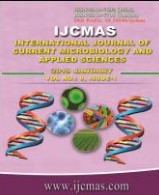


 National Academy of Agricultural Sciences (NAAS)
National Academy of Agricultural Sciences (NAAS)

|
PRINT ISSN : 2319-7692
Online ISSN : 2319-7706 Issues : 12 per year Publisher : Excellent Publishers Email : editorijcmas@gmail.com / submit@ijcmas.com Editor-in-chief: Dr.M.Prakash Index Copernicus ICV 2018: 95.39 NAAS RATING 2020: 5.38 |
The reference evapotranspiration (ETo) is an important agrometeorological parameter which has been used in a number of applications. In present study daily ETo was determined for seven districts of Marathwada region having long period (29-35 years) weather data by Hargreaves method. The Kc values for kharif sorghum, maize and pearlmillet as given in FAO-56 paper was used to calculate the daily crop water requirement (ETc). The results revealed that, ETo reaches to its peak value during 28th April to 18th May at all the districts of marathwada region. Among the districts, Parbhani had highest ETo and Aurangabad had lowest ETo followed by Nanded, Latur, Osmanabad, Beed and Jalna. The mean water requirement (ETc) of kharif sorghum during initial stage was found to be lower (1.83 to 2.0 mm day-1) and it increased during developmental stage (3.34 to 3.70 mm day-1) and during mid season stage (4.70 to 5.10 mm day-1) and decreased during late-season stage (2.91 to 3.13 mm day-1). The total water requirement across the districts varies between Parbhani (436.04 mm) to Aurangabad (399.42 mm). The mean water requirement of kharif maize during initial stage (1.59 to 1.74 mm day-1), during developmental stage (2.77 to 3.08 mm day-1), during mid season stage (5.07 to 5.54 mm day-1) and during late season stage it decreases (1.55 to 1.67 mm day-1). The total water requirement of kharif maize varies between Parbhani (373.13 mm) and Aurangabad (340.74 mm). The mean water requirement of kharif pearlmillet during initial stage (1.85 to 2.03 mm day-1), during developmental stage (2.82 to 3.13 mm day-1), during mid season stage (4.21 to 4.64 mm day-1) and during late season stage it decreases (1.29 to 1.38 mm day-1). The total water requirement of kharif pearlmillet varies between Parbhani (291.69 mm) and Aurangabad (265.02 mm).
 |
 |
 |
 |
 |